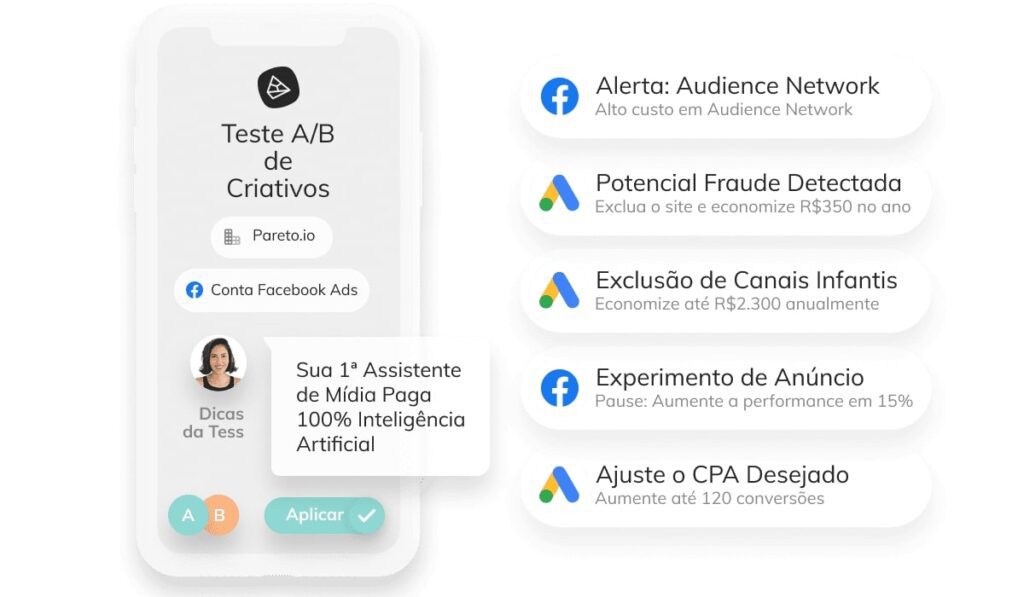Anyone who works in a digital marketing agency knows that improving client performance is always a challenge. Especially when the main demands involve short-term strategic actions and real-time monitoring.
In many cases, the monitoring of metrics, the analysis of results and paid media management itself are compromised by the difficulty of monitoring several client accounts with a high volume of information simultaneously.
That's where Robotic Process Automation (RPA) comes in. This software technology automates repetitive tasks and helps maximize customer results on a large scale, reducing the margin for error and increasing productivity.
Performance Agencies' main challenges
Every marketing agency has its challenges, many of which are repeated and common among them. Here are the main difficulties that agencies face on a daily basis and which have a direct impact on results.
Manage Several Customer Accounts Simultaneously
Managing several client accounts at the same time is an exhausting task that requires constant attention to the smallest detail in order to monitor metrics by period, analyze CPA, ROAS, CPV and CPC targets, among others.
Depending on the number of clients under their responsibility, it can take a long time for the media manager to carry out this activity, as they will need to access the accounts individually on different platforms to extract the data, a tedious task to be carried out continuously.
However, with the use of RPAs it is possible to monitor the performance of all clients on a single screen. This way, media managers can have a broad view of their client portfolio and take action in each case that needs attention, such as a drop in performance.
Controlling the Budget for Paid Media Accounts
Controlling the budget for paid media accounts is a seemingly easy task, but one that requires extra attention if you don't want to make mistakes and end up spending over or under what was planned for a given period, thus jeopardizing the monthly budget.
After defining the client's budget and launching the campaigns, a journey of daily monitoring of spending begins so that the investments earmarked for the ads can be used to best advantage in the agreed period.
With the use of automation, the entire process of calculating the distribution of the budget for the month and the daily adjustments takes place automatically, so the professional gains time to devote to other activities in their working day.
Monitoring the Team's Work
In order to monitor the team's work, identify those who need the most help and ensure good performance on client accounts, leaders increasingly need to resort to technologies that make it easier to follow up more accurately.
The use of spreadsheets, daily meetings and the sending of several emails to the team take up a lot of time and are often not enough to drive strategic action.
But there are other ways of monitoring this. By using RPAs, leaders can visualize the performance of employees and their respective clients on dashboards, anticipating possible problems and directing the team's actions.
Taking Business to the Next Level
Scaling up an agency is always a challenge, especially in a segment like digital marketing. In addition to creative, strategic and relationship work, employees end up wasting a lot of time on totally repetitive activities.
This growth, in addition to reducing employee satisfaction and engagement, often requires agencies to hire new employees just to do repetitive tasks, failing to offer them opportunities to exercise their creative potential.
This is where the advantage of automation comes in: those who use RPAs can direct a large part of the repetitive activities to software, while making the most of the team's potential, and at the same time increasing their satisfaction and development.
How Can Marketing Automation Tools Help?
In general, RPAs manipulate data in the same way as humans, but in much less time, which is why this automation is considered a tool that optimizes productivity in companies.
And it's no different in the digital marketing world, which is full of repetitive tasks involving different systems that can be optimized with the use of automation.
For example, a robot can quickly identify each customer's projections in real time, thus facilitating account management and increasing the productivity of the team, which will then work on the accounts that really have opportunities or need optimizing.
See how RPAs can transform your marketing agency and make it more efficient:
- Business scalability: RPAs boost the growth of agencies by increasing productivity, without the need to hire new tools or proportionally increase staff to meet the increased demand from clients;
- Data management: automation tools integrate the work of marketing, sales and after-sales service, making it possible to enrich data analysis and improve the customer experience;
- Reducing the sales cycle: RPAs speed up the assignment of leads in the marketing funnel, automating the processes from lead qualification to closing the sale;
- Increased performance: the use of RPAs facilitates the management of customer accounts with omnichannel dashboards, giving predictability to possible failures and opportunities to improve performance.
5 Marketing Automations for Performance Agencies
Pareto is an Artificial Intelligence company focused on RPAs for Marketing and Sales. Throughout its history, it has developed automations that are used in more than 140 countries.
1. 360º Dashboard for Performance Agencies
Pareto's 360º Dashboard makes it easy to access projections for each of your clients' accounts. On a single screen you can track metrics and budget by period, as well as analyze your CPA, ROAS, CPV and CPC targets, for example.
Not to mention that you can customize the dashboard according to your agency's needs, you can filter the data by your team's account manager and by client to get a more accurate view of the results.
This way, a media manager can keep track of their entire client portfolio and, with a few clicks, optimize campaigns and automate the month's budget.
The agency director, on the other hand, can anticipate potential problems by knowing which clients and portfolios have the best and worst projected results for the month.
2. 1-Click Optimization for Facebook Ads and Google Ads
A paid media analyst can spend several hours of his or her working day looking for optimizations to make to paid media accounts, be it in targeting, ads, budgets, etc.
But many of these manual searches can be automated. Pareto's One Click Optimization performs thousands of analyses in seconds, looking for the best optimization opportunities in an ad account, such as:
- blocking potentially fraudulent channels on the Google Display Network;
- deactivation of ads with low performance on Facebook Ads;
- adding new keywords to Google, among others.
After performing the analysis, our robot selects the best optimization opportunities for the media accounts and displays them in suggestions that appear as cards in a kanban, just like Trello cards.
The analyst can evaluate all the day's suggestions and choose which ones to apply. Finally, the optimizations applied are saved and can be viewed by other team members, the manager or customers.
3. Omnichannel Budget Manager
With Pareto's Budget Manager, you can group your paid media campaigns by criteria (which can be the same objective, funnel stage, location or platform) and define the budget for the month.
Every day our robot analyzes the performance of groups of Google Ads and Facebook Ads campaigns, and adjusts the budget automatically to maximize results and match the stipulated budget.
For example, an e-commerce business with 5 bottom-of-funnel campaigns focused on ROAS, 2 on Google Ads and 3 on Facebook Ads, could group them together and select a budget of R$10,000.00 for the month.
Thus, Pareto will analyze the performance of each one on a daily basis and distribute the month's budget among the best in the period, including weekends and holidays.

4. Media Optimization for Pre-Qualified Leads
In e-commerce campaigns, as the sale is directly online, it's easy to see the real return on investment. However, in campaigns that generate sales opportunities through forms, the return is not so visible.
These campaigns have more or less qualified leads. It turns out that when you optimize media campaigns to maximize the volume of conversions, the volume of qualified leads doesn't always increase.
This is because paid media platforms don't see the difference between a qualified lead and an unqualified one, as they consider both to be conversions.
This problem significantly affects the agency's clients, whose goal is to generate leads for the sales department. After all, sometimes the media analyst prioritizes campaigns that have a cheaper cost per lead, but without taking into account that these are much more unqualified.
Even the agency itself suffers from this problem/challenge when it campaigns to attract clients for itself.
With this in mind, Pareto has developed this Qualified Leads Automation that monitors your form, automatically assigning a score to each lead captured, thus separating qualified leads from unqualified ones.
And it doesn't end there: in addition to making this selection, RPA sends the scores of qualified leads to the Google Ads and Facebook Ads platforms, optimizing campaigns for the leads with the greatest chance of becoming customers.
5. Omnichannel Dashboard by Customer
There are simple activities that a paid media analyst can take a lot of time to perform, such as analyzing the overall performance of your client's account.
This delay is due to the difficulty of extracting all the KPIs, accessing each platform individually, and then unifying the data and making a complete analysis.
Can you imagine receiving a last-minute call from your client asking how your account is and taking several minutes to respond? The customer may become impatient waiting for this information, even giving the impression of a lack of professionalism.
With Pareto's Omnichannel Dashboard by Customer, you have all the KPIs of up to 180 platforms in a single place and can visualize all the data to make more strategic decisions, reaching a level of depth that is only possible with BI.

As you can see, marketing agencies are innovating all the time. The reliance on people to carry out dull, repetitive tasks in weeks can now be replaced by automation that can do them in minutes.
But that doesn't mean that agencies no longer need marketing professionals. On the contrary, they need the human skills of these professionals much more than the manual or extremely analytical side.
Pareto believes that automation is capable of optimizing processes and increasing the productivity of marketing agencies, but that the creative and strategic capacity of professionals is what makes it possible to create successful campaigns.
Optimize your agency's repetitive and mechanical activities and free people to be more human, brilliant and creative! Contact Pareto Experts now!






